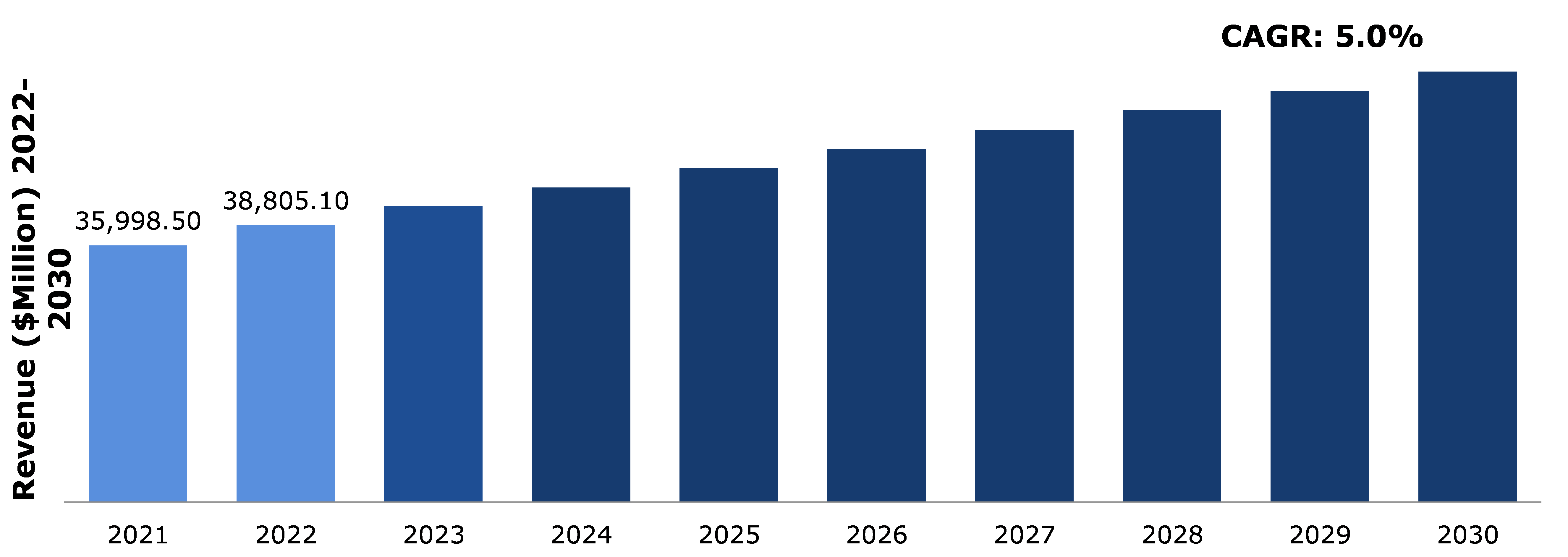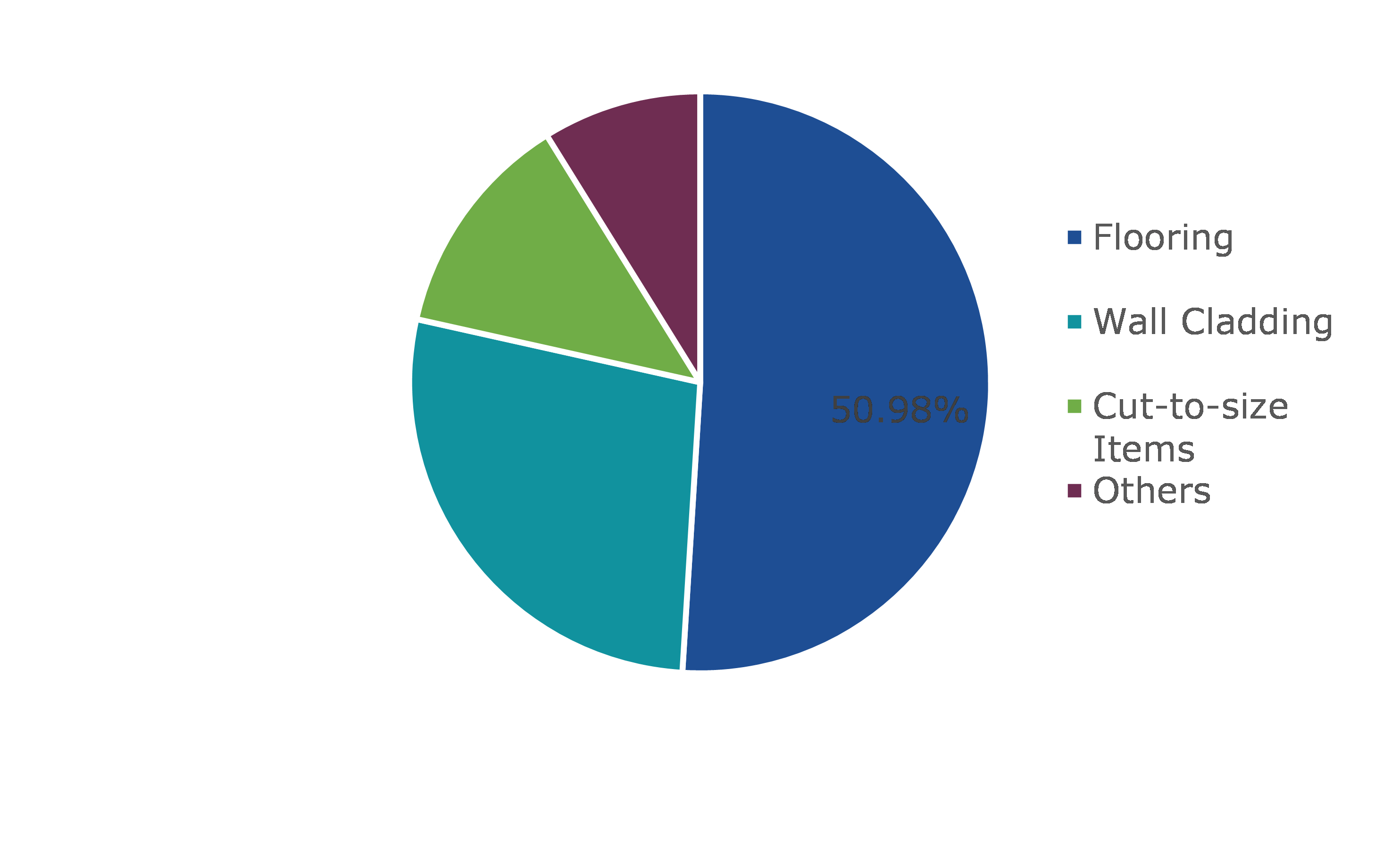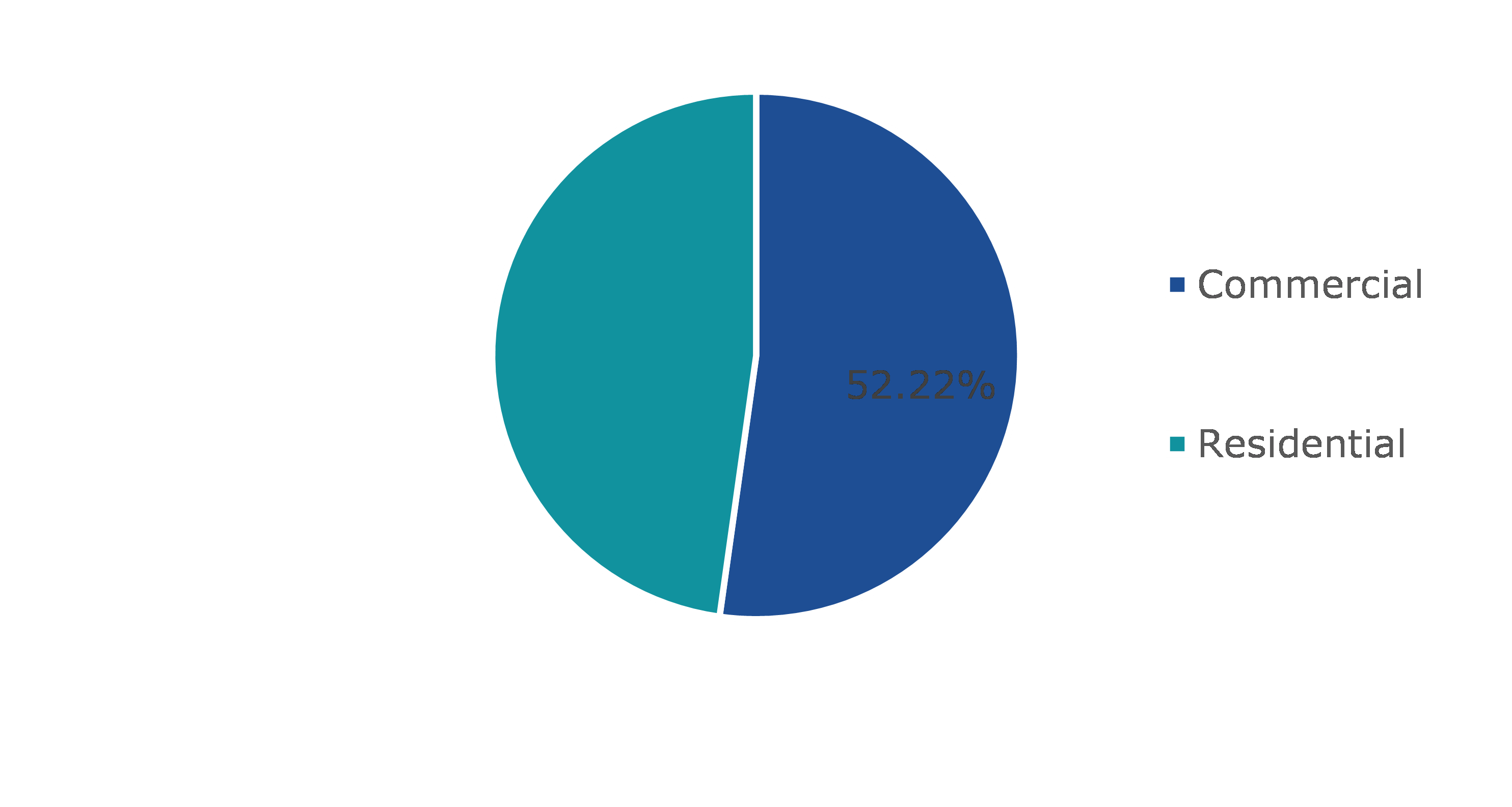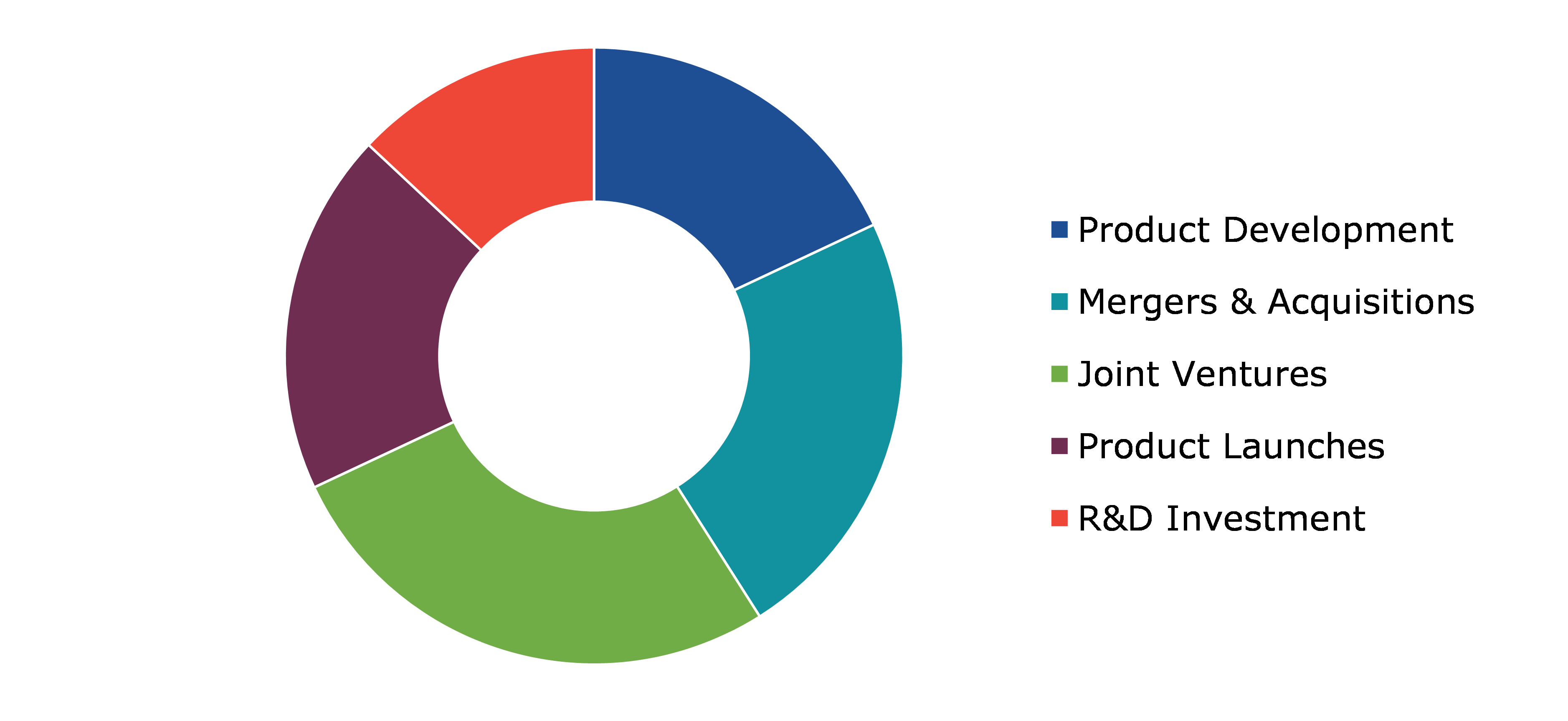Natural Stone Market Report
RA08515
Natural Stone Market by Type (Granite, Marble, Limestone, Travertine, and Others), Application (Flooring, Wall Cladding, Cut-to-size Items, and Others), End-use Industry (Residential and Commercial), and Regional Analysis (North America, Europe, Asia-Pacific, and LAMEA): Global Opportunity Analysis and Industry Forecast, 2022-2030
Global Natural Stone Market Analysis
The global natural stone market is predicted to be valued at $60,367.30 million by 2030, surging from $35,998.50 million in 2021, at a noteworthy CAGR of 5.0%.
Market Synopsis
Natural stone market is gaining huge popularity as natural stones such as marble, granite, travertine, limestone, onyx, and sandstone find wide range of application across kitchen countertops, flooring, wall cladding, fireplaces, and others. Natural stones such as marble and granite have limitless design potential and exhibit high durability. The well-known and world-famous old buildings and monuments are built using natural stones namely Taj Mahal, Agra, The Great Pyramid, and The Coliseum.
However, the porous, soft, and brittle nature of natural stone is anticipated to restrain the market growth. For instance, some of the natural stones are porous and absorb stains more easily. Due to this, they must be sealed properly and resins must be used for longevity.
The versatile characteristics of natural stones such as timeless appeal and immense beauty are estimated to attract huge growth opportunities. Natural stone adds elegance and aesthetic to any space whether it is an architectural design or ornamental design structure such as statue. In addition, recent advancements in natural stone quarrying, extraction, and fabrication process such as sandblasting, 3D modeling, and detailed surface work have made natural stones easier to use and durable which is anticipated to boost the natural stone market share during the analysis timeframe.
According to regional analysis, the natural stone market in Asia-pacific region generated a revenue of $19,907.20 million in 2021 and is projected to reach up to $35,170.00 million by 2030.
Natural Stone Overview
Natural stones are produced by complex geological processes, and they are quarried & mined from earth. Natural stone is regarded as a premier building material because of its uniqueness as no two natural stones are exactly same, stable, and grandeur. Various natural stones such as granite, sandstone, marble, travertine, onyx, and limestone have limitless design potential and green attributes that promote sustainability. For instance, natural stone contributes towards LEED (Leadership in Energy and Environmental Design), which is widely adopted green building rating system. Some of the popular ancient monuments and incredible structures were built using natural stone like the Taj Mahal located in Agra, India, the Washington Monument located in Washington D.C, U.S., the Colosseum located in Rome, Italy, the Egyptian Pyramids Giza located in Egypt, and many others.
COVID-19 Impact on Natural Stone Market
The global crisis caused by COVID-19 pandemic has negatively affected the natural stone market and brought real challenges for its functioning. For instance, the quarry activities, processing facilities, logistics, and administrative offices in natural stone industry had to suspend their operations to contain the pandemic. The lockdown imposed across various countries forced the natural stone manufacturers to go into complete lockdown mode that led to economic crisis and laying off employees. The companies were unable to meet the demand from ongoing essential construction projects such as building of hospitals due to transport restrictions and reluctance of workers to work due to the fear of COVID-19 virus. The import-export of natural stone was negatively impacted that led to drastic decline in the demand from domestic and foreign market. All these factors have negatively impacted the natural stone market size during the pandemic.
Various government initiatives which notified that few industries including those related to construction sector can start their work with minimal staff, social distancing norms, and proper precautions have helped the natural stone manufacturers to start their business operations. Towards the end of 2020, many construction sites had resumed their normal operations that indirectly helped the natural stone manufacturers to pick up the pace. Various safety & hygiene protocols were introduced such as social distancing norms, regular health checkup of workers, and others that have helped natural stone manufacturers to balance the available minimal workforce and to meet the natural stone demand during the pandemic.
Wide Range of Applications of Natural Stone to Drive the Market Growth
Natural stone finds variety of applications in the interior spaces of your home such as kitchen, bathroom, living room, and others. For instance, granite, one of the hardest stones, is widely used in kitchen countertops which is known for its durability and heat resistance capacity. This natural stone is known for its elegance and unique pattern as no two granite slabs are alike and can meet the demands of busiest kitchen without any signs of wear. Marble is widely used for flooring, columns, steps, table, or countertop. Onyx, which is formed from limestone, is available in many colors and it is used for walls to enhance its translucent color. Quartzite is used as building blocks and slabs. Limestone formed from calcium carbonate is used in building construction of cornices, facades, and pillars. It is also used for floor tiles, fireplaces, wall tiles, staircases, and others.
To know more about global natural stone market drivers, get in touch with our analysts here.
Presence of Alternative Building Material Such as Ceramic Tiles to Restrain Market Growth
The use of alternative materials such as ceramic tiles is gaining popularity as glazed ceramic tile is ready to use and does not require any additional coating. Whereas the natural stone tiles are porous and can absorb stains due to which they must be sealed properly and resins must be used to close the pores. Ceramic tiles are man-made and available in various colors and patterns. In addition, ceramic tiles can be custom-made to resemble the look of natural stone which is estimated to restrain the natural stone market growth in the upcoming years.
Sharp Rise in Construction Activities Across the World to Generate Enormous Opportunities
The building & construction sector is experiencing significant growth in the recent years owing to rapid urbanization, development of smart cities, and mega projects. Natural stones such as marble, granite, and others are largely used in the residential and commercial sectors for infrastructure developments as well as for reconstruction & remodeling projects. For instance, marble, which is majorly quarried in China, India, Italy, and Spain represents beauty with its inherent warmth and it is a popular choice for floors, fireplace facings, countertops, walls, and windowsills. Owing to its appearance and ease of maintenance, it is widely used for table tops, wall claddings, floor, vanity tops, wainscot, and others. Similarly, soapstone, which is another natural stone, is softest material used for countertops as it is completely resistant to heat and stain. It shows high abrasion and scratch resistance due to which it is used for flooring.
To know more about global natural stone market opportunities, get in touch with our analysts here.
Global Natural Stone Market, by Type
Based on type, the market has been divided into granite, marble, limestone, travertine, and others. Among these, the granite sub-segment accounted for the highest revenue share in 2021 and is estimated to show the fastest growth during the forecast period.
Global Natural Stone Market Share, by Type, 2021
Source: Research Dive Analysis
The granite sub-segment is anticipated to have a dominant market share and shall surpass $23,376.80 million by 2030, with an increase from $13,074.50 million in 2021. This is because granite adds value to your home and investing in this countertop will increase your home’s sale price. This is because granite is known for outstanding hardness, abrasion resistance, and elegance. Granite is resilient stone that can resist very high temperature due to which it is used as kitchen countertops where the granite is subjected to direct heat. Granite is available in variety of colors and patterns with distinctive veins, swirls, and specks which are eye-catching. Also, granite countertops are easy to clean owing to its smooth and polished surface. As granite can resist abrasion, bear significant weight, can resist weathering, and has brilliant polish, they make it a desirable and popular natural stone.
Global Natural Stone Market, by Application
Based on application, the market has been divided into flooring, wall cladding, cut-to-size items, and others. Among these, the flooring sub-segment accounted for the highest market share in 2021 and is estimated to show the fastest growth during 2022-2030.
Global Natural Stone Market Share, by Application, 2021
Source: Research Dive Analysis
The flooring sub-segment is anticipated to have a dominant market share and shall surpass $31,971.30 million by 2030, with an increase from $18,352.10 million in 2021. Natural stone is widely used for flooring in residential and commercial sectors owing to its durability, beauty, and increased value to your home. Natural stone has organic surface that can resist dust & allergenic organisms, thus making your flooring safe and durable. Some of the popular natural stones preferred for flooring include marble, granite, slate, and limestone. For instance, the marble used for flooring provides the ambience of luxury and antiquity. It comes in wide range of colors and shades that provide pristine appeal. Slate is preferred natural stone for flooring as it is easy to cut and turn into sheets. Slate is mostly available in grey, gold, and black colors which works well for both dry and wet areas. Due to its stain resistance properties, slate is an ideal solution for flooring in hallway, bathroom, living room, kitchen areas, and dining.
Global Natural Stone Market, by End-use Industry
Based on end-use industry, the market is further classified into residential and commercial. Among these, the commercial sub-segment is anticipated to have a dominant market share and residential sub-segment is projected to the have fastest growth during the timeframe.
Global Natural Stone Market Share, by End-use Industry, 2021
Source: Research Dive Analysis
Commercial sub-segment is anticipated to have the highest market share in the forecast time period and shall surpass $30,809.80 million by 2030, with an increase from $18,798.30 million in 2021. The sub-segment growth is attributed to rising demand for natural stones for flooring in commercial buildings like shopping centers and big complexes. Natural stones are available in a variety of textures and colors. Thus, these stones provide esthetic and appealing look to the buildings.
Global Natural Stone Market, Regional Insights
The natural stone market was investigated across North America, Europe, Asia-Pacific, and LAMEA.
Global Natural Stone Market Size and Forecast, By Region, 2021 to 2030 ($ Million)
Source: Research Dive Analysis
The Market for Natural Stone in Asia-Pacific to be the Most Dominant and is Anticipated to Show the Fastest Growth
The Asia-Pacific natural stone market accounted $19,907.20 million in 2021 and is projected to grow with a CAGR of 6.3%. Growing construction activities owing to rapid urbanization & industrialization are estimated to boost the demand for natural stones for flooring, wall cladding, memorial arts, civil works, and others. The presence of leading natural stone producers namely India and China is estimated to boost the Asia-Pacific natural stone market size. For instance, as stated on August 13, 2018, in the World of Stones, well-known exporter and supplier of quality natural stone, India accounts for 27% of commercial natural stone production from its quarries. In addition, the export of natural stones in India is estimated to be around $300 million each year. The Makarana area of Rajasthan, India, is popular for calcite marble available in white and different varieties. Also, the percentage of export of Indian green marble found in Keshryaji, near Udaipur, Rajasthan, is high. In addition, one-fourth of the world’s granite deposits are found in India and these granite countertops are widely exported to the U.S.
In the future, India's natural stone sector is predicted to expand dramatically. Due to its diversified geographical location, India has abundant stone reserves. According to an article posted on the International Labor Organization, India would rank third in global natural stone production in 2022, with a nearly 11% share of the world natural stone market. Rajasthan is the most important and significant contributor to the country's mining industry, accounting for almost 90% of the country's sandstone production. Natural stone deposits can be found all over Rajasthan, including in Kota, Bharatpur, Tonk, and Sawai Madhopur. Natural stone extraction, processing, export, and import are the primary drivers of the country's natural stone sector.
Competitive Scenario in the Global Natural Stone Market
Investment and acquisition are common strategies followed by major market players.
Source: Research Dive Analysis
Some of the leading natural stone market players are ARO Granite Industries Ltd., Dimpomar, Dermitzakis Bros S. A., Levantina Asociados de Minerales, S.A., Margraf Spa, Mumal Marbles Pvt. Ltd., Polycor Inc., Temmer Marble, Ranamar, and Xishi Stone Group.
| Aspect | Particulars |
| Historical Market Estimations | 2020-2021 |
| Base Year for Market Estimation | 2021 |
| Forecast Timeline for Market Projection | 2022-2030 |
| Geographical Scope | North America, Europe, Asia-Pacific, LAMEA |
| Segmentation by Type |
|
| Segmentation by Application |
|
| Segmentation by End-use Industry se |
|
| Key Companies Profiled |
|
Q1. What is the size of the global natural stone market?
A. The global natural stone market is predicted to be valued at $60,367.30 million by 2030, surging from $35,998.50 million in 2021, at a noteworthy CAGR of 5.0%
Q2. Which are the major companies in the natural stone market?
A. ARO Granite Industries Ltd., Dimpomar, and Dermitzakis Bros S. A. are some of the key players in the global natural stone market.
Q3. Which region, among others, possesses greater investment opportunities in the near future?
A. The Asia-Pacific region possesses great investment opportunities for investors to witness the most promising growth in the future.
Q4. What will be the growth rate of the Asia-Pacific natural stone market?
A. Asia-Pacific natural stone market is anticipated to grow at 6.3% CAGR during the forecast period.
Q5. What are the strategies opted by the leading players in this market?
A. Investment and acquisition are the two key strategies opted by the operating companies in this market.
Q6. Which companies are investing more on R&D practices?
A. Levantina Asociados de Minerales, S.A., Margraf Spa, and Polycor Inc. are the companies investing more on R&D activities for developing new products and technologies.
Q7. What are the different types of natural stone?
A. The different types of natural stones are marble, granite, travertine, limestone, slate, sandstone, quartzite, and others.
Q8. What type of stone is travertine?
A. Travertine is a type of natural stone formed by mineral deposits from natural springs which is created by rapid precipitation of calcium carbonate.
1.Research Methodology
1.1.Desk Research
1.2.Real time insights and validation
1.3.Forecast model
1.4.Assumptions and forecast parameters
1.5.Market size estimation
1.5.1.Top-down approach
1.5.2.Bottom-up approach
2.Report Scope
2.1.Market definition
2.2.Key objectives of the study
2.3.Report overview
2.4.Market segmentation
2.5.Overview of the impact of COVID-19 on natural stone market
3.Executive Summary
4.Market Overview
4.1.Introduction
4.2.Growth impact forces
4.2.1.Drivers
4.2.2.Restraints
4.2.3.Opportunities
4.3.Market value chain analysis
4.3.1.List of raw material suppliers
4.3.2.List of manufacturers
4.3.3.List of distributors
4.4.Innovation & sustainability matrices
4.4.1.Technology matrix
4.4.2.Regulatory matrix
4.5.Porter’s five forces analysis
4.5.1.Bargaining power of suppliers
4.5.2.Bargaining power of consumers
4.5.3.Threat of substitutes
4.5.4.Threat of new entrants
4.5.5.Competitive rivalry intensity
4.6.PESTLE analysis
4.6.1.Political
4.6.2.Economical
4.6.3.Social
4.6.4.Technological
4.6.5.Environmental
4.7.Impact of COVID-19 on Natural stone market
4.7.1.Pre-covid market scenario
4.7.2.Post-covid market scenario
5.Natural stone Market, by Type
5.1.Overview
5.1.1.Market size and forecast, by type
5.2.Granite
5.2.1.Key market trends, growth factors, and opportunities
5.2.2.Market size and forecast, by region, 2022-2030
5.2.3.Market share analysis, by country 2022 & 2030
5.3.Marble
5.3.1.Key market trends, growth factors, and opportunities
5.3.2.Market size and forecast, by region, 2022-2030
5.3.3.Market share analysis, by country 2022 & 2030
5.4.Limestone
5.4.1.Key market trends, growth factors, and opportunities
5.4.2.Market size and forecast, by region, 2022-2030
5.4.3.Market share analysis, by country 2022 & 2030
5.5.Travertine
5.5.1.Key market trends, growth factors, and opportunities
5.5.2.Market size and forecast, by region, 2022-2030
5.5.3.Market share analysis, by country 2022 & 2030
5.6.Others
5.6.1.Key market trends, growth factors, and opportunities
5.6.2.Market size and forecast, by region, 2022-2030
5.6.3.Market share analysis, by country 2022 & 2030
5.7.Research Dive Exclusive Insights
5.7.1.Market attractiveness
5.7.2.Competition heatmap
6.Natural stone Market, by Application
6.1.Overview
6.1.1.Market size and forecast, by application
6.2.Flooring
6.2.1.Key market trends, growth factors, and opportunities
6.2.2.Market size and forecast, by region, 2022-2030
6.2.3.Market share analysis, by country 2022 & 2030
6.3.Wall Cladding
6.3.1.Key market trends, growth factors, and opportunities
6.3.2.Market size and forecast, by region, 2022-2030
6.3.3.Market share analysis, by country 2022 & 2030
6.4.Cut-to-size Items
6.4.1.Key market trends, growth factors, and opportunities
6.4.2.Market size and forecast, by region, 2022-2030
6.4.3.Market share analysis, by country 2022 & 2030
6.5.Others
6.5.1.Key market trends, growth factors, and opportunities
6.5.2.Market size and forecast, by region, 2022-2030
6.5.3.Market share analysis, by country 2022 & 2030
6.6.Research Dive Exclusive Insights
6.6.1.Market attractiveness
6.6.2.Competition heatmap
7.Natural stone Market, by End use
7.1.Overview
7.1.1.Market size and forecast, by end use
7.2.Commercial
7.2.1.Key market trends, growth factors, and opportunities
7.2.2.Market size and forecast, by region, 2022-2030
7.2.3.Market share analysis, by country 2022 & 2030
7.3.Residential
7.3.1.Key market trends, growth factors, and opportunities
7.3.2.Market size and forecast, by region, 2022-2030
7.3.3.Market share analysis, by country 2022 & 2030
7.4.Research Dive Exclusive Insights
7.4.1.Market attractiveness
7.4.2.Competition heatmap
8.Natural stone Market, by Region
8.1.North America
8.1.1.U.S.
8.1.1.1.Market size analysis, by Type
8.1.1.2.Market size analysis, by Application
8.1.1.3.Market size analysis, by end use
8.1.2.Canada
8.1.2.1.Market size analysis, by Type
8.1.2.2.Market size analysis, by Application
8.1.2.3.Market size analysis, by end use
8.1.3.Mexico
8.1.3.1.Market size analysis, by Type
8.1.3.2.Market size analysis, by Application
8.1.3.3.Market size analysis, by end use
8.1.4.Research Dive Exclusive Insights
8.1.4.1.Market attractiveness
8.1.4.2.Competition heatmap
8.2.Europe
8.2.1.Germany
8.2.1.1.Market size analysis, by Type
8.2.1.2.Market size analysis, by application
8.2.1.3.Market size analysis, by end use
8.2.2.UK
8.2.2.1.Market size analysis, by Type
8.2.2.2.Market size analysis, by Application
8.2.2.3.Market size analysis, by end use
8.2.3.France
8.2.3.1.Market size analysis, by Type
8.2.3.2.Market size analysis, by Application
8.2.3.3.Market size analysis, by end use
8.2.4.Spain
8.2.4.1.Market size analysis, by Type
8.2.4.2.Market size analysis, by Application
8.2.4.3.Market size analysis, by end use
8.2.5.Italy
8.2.5.1.Market size analysis, by Type
8.2.5.2.Market size analysis, by Application
8.2.5.3.Market size analysis, by end use
8.2.6.Rest of Europe
8.2.6.1.Market size analysis, by Type
8.2.6.2.Market size analysis, by Application
8.2.6.3.Market size analysis, by end use
8.2.7.Research Dive Exclusive Insights
8.2.7.1.Market attractiveness
8.2.7.2.Competition heatmap
8.3.Asia Pacific
8.3.1.China
8.3.1.1.Market size analysis, by Type
8.3.1.2.Market size analysis, by Application
8.3.1.3.Market size analysis, by end use
8.3.2.Japan
8.3.2.1.Market size analysis, by Type
8.3.2.2.Market size analysis, by Application
8.3.2.3.Market size analysis, by end use
8.3.3.India
8.3.3.1.Market size analysis, by Type
8.3.3.2.Market size analysis, by Application
8.3.3.3.Market size analysis, by end use
8.3.4.Australia
8.3.4.1.Market size analysis, by Type
8.3.4.2.Market size analysis, by Application
8.3.4.3.Market size analysis, by end use
8.3.5.South Korea
8.3.5.1.Market size analysis, by Type
8.3.5.2.Market size analysis, by Application
8.3.5.3.Market size analysis, by end use
8.3.6.Rest of Asia Pacific
8.3.6.1.Market size analysis, by Type
8.3.6.2.Market size analysis, by Application
8.3.6.3.Market size analysis, by end use
8.3.7.Research Dive Exclusive Insights
8.3.7.1.Market attractiveness
8.3.7.2.Competition heatmap
8.4.LAMEA
8.4.1.Brazil
8.4.1.1.Market size analysis, by Type
8.4.1.2.Market size analysis, by Application
8.4.1.3.Market size analysis, by end use
8.4.2.Saudi Arabia
8.4.2.1.Market size analysis, by Type
8.4.2.2.Market size analysis, by Application
8.4.2.3.Market size analysis, by end use
8.4.3.UAE
8.4.3.1.Market size analysis, by Type
8.4.3.2.Market size analysis, by Application
8.4.3.3.Market size analysis, by end use
8.4.4.South Africa
8.4.4.1.Market size analysis, by Type
8.4.4.2.Market size analysis, by Application
8.4.4.3.Market size analysis, by end use
8.4.5.Rest of LAMEA
8.4.5.1.Market size analysis, by Type
8.4.5.2.Market size analysis, by Application
8.4.5.3.Market size analysis, by end use
8.4.6.Research Dive Exclusive Insights
8.4.6.1.Market attractiveness
8.4.6.2.Competition heatmap
9.Competitive Landscape
9.1.Top winning strategies, 2021
9.1.1.By strategy
9.1.2.By year
9.2.Strategic overview
9.3.Market share analysis, 2021
10.Company Profiles
10.1.ARO Granite Industries Ltd.
10.1.1.Overview
10.1.2.Business segments
10.1.3.Type portfolio
10.1.4.Financial performance
10.1.5.Recent developments
10.1.6.SWOT analysis
10.2.Dimpomar
10.2.1.Overview
10.2.2.Business segments
10.2.3.Type portfolio
10.2.4.Financial performance
10.2.5.Recent developments
10.2.6.SWOT analysis
10.3.Dermitzakis Bros S. A.
10.3.1.Overview
10.3.2.Business segments
10.3.3.Type portfolio
10.3.4.Financial performance
10.3.5.Recent developments
10.3.6.SWOT analysis
10.4.Levantina Asociados de Minerales, S.A.
10.4.1.Overview
10.4.2.Business segments
10.4.3.Type portfolio
10.4.4.Financial performance
10.4.5.Recent developments
10.4.6.SWOT analysis
10.5.Margraf Spa
10.5.1.Overview
10.5.2.Business segments
10.5.3.Type portfolio
10.5.4.Financial performance
10.5.5.Recent developments
10.5.6.SWOT analysis
10.6.Mumal Marbles Pvt. Ltd.
10.6.1.Overview
10.6.2.Business segments
10.6.3.Type portfolio
10.6.4.Financial performance
10.6.5.Recent developments
10.6.6.SWOT analysis
10.7.Polycor Inc.
10.7.1.Overview
10.7.2.Business segments
10.7.3.Type portfolio
10.7.4.Financial performance
10.7.5.Recent developments
10.7.6.SWOT analysis
10.8.Temmer Marble
10.8.1.Overview
10.8.2.Business segments
10.8.3.Type portfolio
10.8.4.Financial performance
10.8.5.Recent developments
10.8.6.SWOT analysis
10.9.Ranamar
10.9.1.Overview
10.9.2.Business segments
10.9.3.Type portfolio
10.9.4.Financial performance
10.9.5.Recent developments
10.9.6.SWOT analysis
10.10.Xishi Stone Group
10.10.1.Overview
10.10.2.Business segments
10.10.3.Type portfolio
10.10.4.Financial performance
10.10.5.Recent developments
10.10.6.SWOT analysis
11.Appendix
11.1.Parent & peer market analysis
11.2.Premium insights from industry experts
11.3.Related reports
Natural stones, as the name suggests, are naturally occurring lithic materials that are quarried from earth and used extensively as building materials. These lithic materials include sandstone, marble, onyx, quartzite, granite, limestone, travertine, etc. Natural stones have been used as building materials and for decorative enhancements since ancient times and examples of such buildings include the Pyramids, the Taj Mahal, etc. Since these stones possess limitless design potential and great durability, they are nowadays used for a wide range of applications such as for flooring, fireplaces, kitchen countertops, etc. in residential and commercial projects.
Forecast Analysis of the Global Market
In the recent years, there has been an increase in the demand for natural stones owing to the wide range of construction applications in which they can be used. From kitchen countertops to fireplaces, natural stones come in handy as they give a unique and distinct look to home interiors. This growing demand for different types of natural stones in the construction sector is expected to be the primary growth driver of the global natural stone market in the coming years. Along with this, recent technological advancements have simplified the processes of quarrying, extracting, and fabricating these naturals stones which has made it quite easier to use these stones. This is expected to push the natural stone market further. Also, sharp rise in construction activities all across the globe is predicted to offer numerous investment and growth opportunities to the market in the analysis timeframe. However, presence of alternative building materials such as ceramic tiles may restrain the growth of the market in the forecast period.
According to the report published by Research Dive, the global natural stone market is expected to gather a revenue of $60,367.30 million by 2030 and grow at 5.0% CAGR in the 2022–2030 timeframe. Regionally, the natural stone market in the Asia-Pacific region is expected to be the most dominant as well as have the fastest growth rate of 6.3% CAGR by 2030. Growth in the number of construction activities due to rapid urbanization and industrialization in this part of the world is anticipated to become the primary growth driver of the market in this region. Additionally, presence of leading natural stone producing countries like India and China is expected to the push the market in this region further.
Covid-19 Impact on the Market
The outbreak of the Covid-19 pandemic has had a massive negative effect on almost all industries and businesses across the world. The natural stone market faced a similar fate due to the pandemic. Almost all the quarrying, extraction, and fabrication processes virtually came to a halt due to the pandemic and the subsequent lockdowns that were put in place to curb the spread of the virus. Along with this, majority of the construction activities across the globe were stopped due to the lockdowns which led to a decline in the demand and growth rate of the global market. All these factors have collectively imposed a disastrous impact on the natural stone market.
Significant Market Developments
Some prominent players in the global natural stone market include ARO Granite Industries Ltd., Levantina Asociados de Minerales, S.A., Polycor Inc., Dimpomar, Margraf Spa, Temmer Marble, Xishi Stone Group, Dermitzakis Bros S. A., Mumal Marbles Pvt. Ltd., Ranamar, and many others.
The significant companies operating in the industry are adopting numerous growth strategies & business tactics such as partnerships, collaborations, mergers & acquisitions, and launches to maintain a robust position in the overall market, thus helping the natural stones market to flourish. For instance:
In January 2022, Triton Stone Group, a US-based provider of marble and granite, announced the acquisition of Unique Stone Concepts, a leading supplier of natural stones and quartz slabs. The acquisition is expected to help Triton Stone Group, which is among the largest importers of natural stone in the US, to increase its foothold in the market in the coming years.
In March 2022, Architectural Surfaces, a US-based importer and distributor of natural stone, announced the acquisition of two Dallas-based natural stone suppliers, viz., Stone Boutique and Allure. With this acquisition, Architectural Surfaces has consolidated its position in the natural stone market considerably and is expected to continue on this growth trajectory in the years to come.
In June 2022, in a unique collaboration, Mejuri, a leading online jewelry shop, announced a tie-up with Claude Home, an online gallery selling vintage and contemporary artworks from artisans around the globe. The collaboration is aimed at providing natural stone-based storage spaces for ornaments and jewelry sets sold by Mejuri. This collaboration is being touted as a great experiment and will help the natural stone market to grow in such different segments that were unexplored before.
Personalize this research
- Triangulate with your own data
- Request your format and definition
- Get a deeper dive on a specific application, geography, customer or competitor
- + 1-888-961-4454 Toll - Free
- support@researchdive.com







